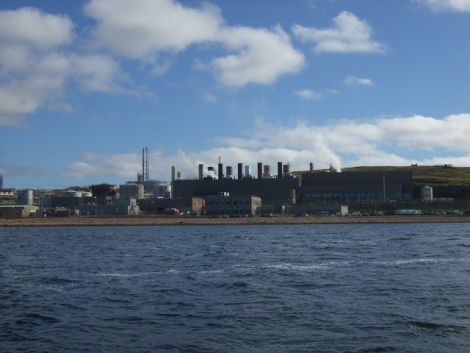Energy / Plans to make Sullom Voe Terminal infrastructure ‘fit for purpose’
THE OPERATOR of the Sullom Voe Terminal is planning to rework its processing facilities to make the infrastructure footprint smaller and reflect “substantially” reduced production rates.
By making the size of the facilities more compact there would be extra space to host new energy opportunities such as hydrogen production – which is a key part of operator EnQuest’s future strategy at the site.
Meanwhile the company has confirmed it is reviewing its options for the power station at Sullom Voe Terminal.
The gas-fired station, which meets around 30 per cent of Shetland’s energy demand from surplus power, is set to go into standby mode after the isles connect to the national grid next year, according to network operator SSEN.
EnQuest said opportunities are being assessed for a potential connection to the Shetland grid that would “allow the terminal to operate on sustainable electricity in the future from Shetland’s onshore wind farms that are currently being developed”.
The project to modernise and make the terminal facilities more fit for purpose revolves around new stabilisation infrastructure.
It will allow for the existing process area and surge tanks to be taken out of service.
It will feature a new run of inlet pipework tied-in downstream of the existing East of Shetland Ninian crude pipeline pig receiver, routing the unstabilised oil through new inlet metering and a new indirect fired heater system.
The proposed development would be located on land within the terminal previously occupied by now removed LPG chilldown facilities.
The terminal first took in oil in the late 1970s, and at its peak it was processing more than 1.5 million barrels of oil a day.
Become a member of Shetland News
It takes in oil from fields to the east and west of Shetland, with tankers stopping by to fill up before shipping it elsewhere to refineries.
As production declines in the waters around Shetland, the terminal is much quieter now than it used to be – and it is left with infrastructure oversized for its needs.
In 1986 over 650 tankers used the port of Sullom Voe, but only 63 crude oil export tankers using the port in 2017/18, for example. There were six tankers over the last four-week period.
A briefing note prepared as part of a planning submission says existing terminal facilities are operating “inefficiently” due to being oversized for current and future production rates.
This in turn means that the power demand at the site is higher than required.
There is also the factor of equipment and infrastructure ageing.
The planning submission said the terminal owners and operator recognise that ongoing oil processing at Sullom Voe is dependent on reducing the costs of running the facility.
They said the new stabilisation project has been crated to deliver the “optimum route to sustainable late life operations”.
Reviews are ongoing to allow the project to get the go-ahead later this year.
The new infrastructure is expected to include a 50m high flare – but the existing flare on site, which is double the size, is expected to stay in case it is needed. The new flare system has been designed to include a seal to avoid the need for flaring under normal operating conditions.
The overall flaring is expected to reduce.
Excess East of Shetland offgas from stabilisation which is surplus to fuel gas requirements will be treated, compressed and injected into the East of Shetland pipeline system or the Shetland Island Regional Gas Export (SIRGE) pipeline.
This will result in eliminating any continuous flaring of East of Shetland gas, and is a charge to current operations as just now all of this gas is used as fuel within the site’s power station.
Planning documents say the project is “seen as one of the pre-cursors to allow SVT to be re-invented as a green energy site, while also making the stabilisation process itself more energy efficient”.
EnQuest has not been shy about revealing its desire to develop the site into a “new energy and decarbonisation hub” in the transition away from oil and gas.
It says the terminal has several competitive advantages in the emerging sector: “including a 1,000-acre industrial site with access to existing oil and gas pipeline infrastructure, deep water port and jetties, the highest wind capacity factor across Europe, and a highly-skilled workforce and local supply chain”.
It is assessing the potential to electrify nearby offshore oil and gas assets and planned developments through a grid connection supplemented with renewable power.
EnQuest also plans to “aggregate and use the excess energy” produced by onshore and offshore wind farms “near Sullom Voe” to make hydrogen and other products such as green ammonia or clean fuels.
It has an ambition to produce one million tonnes of hydrogen per annum, but some questions have been raised about how achievable this will be.
Meanwhile the company said it could use the existing deep-water jetty facilities at the terminal to export hydrogen to the UK, Europe and globally.
EnQuest has also applied for carbon capture and storage licences to the East of Shetland, which could potentially tap into a pipeline system operated by the company.
Regarding the future of the Sullom Voe Terminal power station, a spokesperson for EnQuest said it is exploring its options.
“EnQuest is in discussions with SSEN about the changing power landscape in Shetland and how our operations will link in to any future power solutions,” they said.
A briefing document prepared last year by SSEN on its future overhead power line needs in Shetland highlighted that the terminal’s power station could go into standby mode when the isles are connected to the national grid by subsea cable.
Lerwick Power Station, built in 1953 and the main source of energy in Shetland, is also in line to go into standby mode and will only back into life if there is an outage on the subsea transmission link.
Become a member of Shetland News
Shetland News is asking its readers to consider paying for membership to get additional perks:
- Removal of third-party ads;
- Bookmark posts to read later;
- Exclusive curated weekly newsletter;
- Hide membership messages;
- Comments open for discussion.
If you appreciate what we do and feel strongly about impartial local journalism, then please become a member of Shetland News by either making a single payment, or setting up a monthly, quarterly or yearly subscription.
















































































